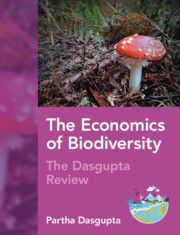Book contents
- The Economics of Biodiversity
- The Economics of Biodiversity
- Copyright page
- Contents
- List of Boxes
- Foreword
- Preface to the CUP Edition
- Preface
- Part I Foundations
- Part II Extensions
- Chapter 14 Distribution and Sustainability
- Chapter 15 Trade and the Biosphere
- Chapter 16 Demand for Provisioning Goods and Its Consequences
- Chapter 17 Managing Nature-Related Financial Risk and Uncertainty
- Chapter 18 Conservation of Nature
- Chapter 19 Restoration of Nature
- Chapter 20 Finance for Sustainable Engagement with Nature
- Part III The Road Ahead
- Appendix
- Acronyms
- Glossary
- References
- Acknowledgements
- Author Index
- Subject Index
Chapter 15 - Trade and the Biosphere
from Part II - Extensions
Published online by Cambridge University Press: 10 March 2025
- The Economics of Biodiversity
- The Economics of Biodiversity
- Copyright page
- Contents
- List of Boxes
- Foreword
- Preface to the CUP Edition
- Preface
- Part I Foundations
- Part II Extensions
- Chapter 14 Distribution and Sustainability
- Chapter 15 Trade and the Biosphere
- Chapter 16 Demand for Provisioning Goods and Its Consequences
- Chapter 17 Managing Nature-Related Financial Risk and Uncertainty
- Chapter 18 Conservation of Nature
- Chapter 19 Restoration of Nature
- Chapter 20 Finance for Sustainable Engagement with Nature
- Part III The Road Ahead
- Appendix
- Acronyms
- Glossary
- References
- Acknowledgements
- Author Index
- Subject Index
Summary
Trade allows goods and services to move great distances from where they are produced to where they are consumed. It has allowed a decoupling of local endowments of natural capital, and production and consumption of goods and services that depend on those assets. As noted in Chapter 4 and 4*, achieving Impact Equality is a condition for global sustainability. But sustainable management of ecosystems at smaller scales remains of key concern. Imbalances between demands on ecosystems and their sustainable supply also occur, affected by where goods and services are consumed and produced, and flows of those goods and services, enabled by domestic and international trade. For example, it is unlikely, indeed near impossible, that a city would be able to meet the needs of its citizens with the ecosystems within its administrative boundary, but this is not necessary if the city can benefit from ecosystem services provided elsewhere.
- Type
- Chapter
- Information
- The Economics of BiodiversityThe Dasgupta Review, pp. 385 - 402Publisher: Cambridge University PressPrint publication year: 2024

